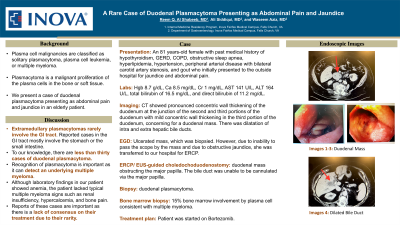Tuesday Poster Session
Category: Small Intestine
P4148 - A Rare Case of Duodenal Plasmacytoma Presenting as Abdominal Pain and Jaundice
Tuesday, October 24, 2023
10:30 AM - 4:00 PM PT
Location: Exhibit Hall

Has Audio
- RA
Reem Al Shabeeb, MD
Inova Fairfax Medical Campus
Fairfax, VA
Presenting Author(s)
Reem Al Shabeeb, MD1, Ali Siddiqui, MD2, Waseem Aziz, MD2
1Inova Fairfax Medical Campus, Fairfax, VA; 2Inova Fairfax Medical Campus, Falls Church, VA
Introduction: Plasma cell malignancies are classified as solitary plasmacytoma, plasma cell leukemia, or multiple myeloma. Plasmacytoma is a malignant proliferation of the plasma cells in the bone or soft tissue. We present a case of duodenal plasmacytoma presenting as abdominal pain and jaundice in an elderly patient.
Case Description/Methods: We present a case of an 81 years-old female with past medical history of hypothyroidism, GERD, COPD, obstructive sleep apnea, hyperlipidemia, hypertension, peripheral arterial disease with bilateral carotid artery stenosis, and gout who initially presented to the outside hospital for jaundice and abdominal pain. Labs were significant for Hgb 8.7 g/dL, Ca 8.5 mg/dL, Cr 1 mg/dL, AST 141 U/L, ALT 164 U/L, total bilirubin of 16.5 mg/dL, and direct bilirubin of 11.2 mg/dL. CT scan showed pronounced concentric wall thickening of the duodenum at the junction of the second and third portions of the duodenum with mild concentric wall thickening in the third portion of the duodenum, concerning for a duodenal mass. There was dilatation of intra and extra hepatic bile ducts. She subsequently had an EGD showing ulcerated mass, which was biopsied. However, due to inability to pass the scope by the mass and due to obstructive jaundice, she was transferred to our hospital for ERCP. ERCP showed duodenal mass obstructing the major papilla. EUS-guided choledochoduodenostomy was successfully performed without complications. Biopsy results with molecular testing came back showing duodenal plasmacytoma. Given plasmacytoma finding, subsequent bone marrow biopsy showed 15% bone marrow involvement by plasma cell consistent with multiple myeloma. Patient was started on Bortezomib.
Discussion: Extramedullary plasmacytomas rarely involve the GI tract, and reported cases in the GI tract mostly involve the stomach or the small intestine. To our knowledge, there are less than thirty cases of duodenal plasmacytoma. Recognition of plasmacytoma is important as it can detect an underlying multiple myeloma. Although laboratory findings in our patient showed anemia, the patient lacked typical multiple myeloma signs such as renal insufficiency, hypercalcemia, and bone pain. Hence making the diagnosis more challenging. Reports of these cases is important as there is a lack of consensus on their treatment due to their rarity.

Disclosures:
Reem Al Shabeeb, MD1, Ali Siddiqui, MD2, Waseem Aziz, MD2. P4148 - A Rare Case of Duodenal Plasmacytoma Presenting as Abdominal Pain and Jaundice, ACG 2023 Annual Scientific Meeting Abstracts. Vancouver, BC, Canada: American College of Gastroenterology.
1Inova Fairfax Medical Campus, Fairfax, VA; 2Inova Fairfax Medical Campus, Falls Church, VA
Introduction: Plasma cell malignancies are classified as solitary plasmacytoma, plasma cell leukemia, or multiple myeloma. Plasmacytoma is a malignant proliferation of the plasma cells in the bone or soft tissue. We present a case of duodenal plasmacytoma presenting as abdominal pain and jaundice in an elderly patient.
Case Description/Methods: We present a case of an 81 years-old female with past medical history of hypothyroidism, GERD, COPD, obstructive sleep apnea, hyperlipidemia, hypertension, peripheral arterial disease with bilateral carotid artery stenosis, and gout who initially presented to the outside hospital for jaundice and abdominal pain. Labs were significant for Hgb 8.7 g/dL, Ca 8.5 mg/dL, Cr 1 mg/dL, AST 141 U/L, ALT 164 U/L, total bilirubin of 16.5 mg/dL, and direct bilirubin of 11.2 mg/dL. CT scan showed pronounced concentric wall thickening of the duodenum at the junction of the second and third portions of the duodenum with mild concentric wall thickening in the third portion of the duodenum, concerning for a duodenal mass. There was dilatation of intra and extra hepatic bile ducts. She subsequently had an EGD showing ulcerated mass, which was biopsied. However, due to inability to pass the scope by the mass and due to obstructive jaundice, she was transferred to our hospital for ERCP. ERCP showed duodenal mass obstructing the major papilla. EUS-guided choledochoduodenostomy was successfully performed without complications. Biopsy results with molecular testing came back showing duodenal plasmacytoma. Given plasmacytoma finding, subsequent bone marrow biopsy showed 15% bone marrow involvement by plasma cell consistent with multiple myeloma. Patient was started on Bortezomib.
Discussion: Extramedullary plasmacytomas rarely involve the GI tract, and reported cases in the GI tract mostly involve the stomach or the small intestine. To our knowledge, there are less than thirty cases of duodenal plasmacytoma. Recognition of plasmacytoma is important as it can detect an underlying multiple myeloma. Although laboratory findings in our patient showed anemia, the patient lacked typical multiple myeloma signs such as renal insufficiency, hypercalcemia, and bone pain. Hence making the diagnosis more challenging. Reports of these cases is important as there is a lack of consensus on their treatment due to their rarity.

Figure: ERCP showing a mass in the second portion of the duodenum.
Disclosures:
Reem Al Shabeeb indicated no relevant financial relationships.
Ali Siddiqui indicated no relevant financial relationships.
Waseem Aziz indicated no relevant financial relationships.
Reem Al Shabeeb, MD1, Ali Siddiqui, MD2, Waseem Aziz, MD2. P4148 - A Rare Case of Duodenal Plasmacytoma Presenting as Abdominal Pain and Jaundice, ACG 2023 Annual Scientific Meeting Abstracts. Vancouver, BC, Canada: American College of Gastroenterology.
